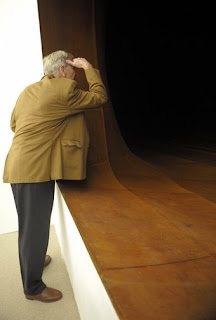As an artist kapoor introduces his stylish flair of art with extreme scale. His concern, like the rest of us as a society, is based around the condition of the world today and how its morals are broken. He uses his art to represent our desire for ‘elsewhere’, with ‘elsewhere ‘ indicating what we as a race purely aspire to have in imagination and the fact that we have no idea how to achieve ‘elsewhere’ to its full potential. Noticeably his art is rather limited in colour detail and pattern, yet when one looks at the shape and grand style he uses it is easy to see how well his work can be. His ‘installations’ are in the state of perfectly polished surfaces, his objects can't easily be ordered into relationships with other things; there are no rivets, visible joins, or perceivable pre-fabricated parts.

“I am interested in sculpture that manipulates the viewer into a specific relationship with both space and time.” –Anish Kapoor, Tate Magazine, July 2007
“I am concerned with the way in which the language of engineering can be turned into the language of the body,”

Kapoors work is conceptual because he presents various subjects that are associated with Architecture, design narrative, manipulation of organic solid materials, and above all the most interesting large scale sculptures I have seen. I see his work as awe-inspiring to the wonder they provide to a viewer. His Sculptures like 'TARATANTARA" and ''The Farm'' the are inspiring to observe because the dynamic form he presents seems as if the sculptures defy gravity.
His work compared to most other gallery artist’s use of space is reasonably different. In his larger than life installation Memory (2008 ) he is confrontational to his observers. This is because the piece literally looms in the viewer’s presence, reminding us of our own relatively tiny scale. The reason this work in particular would create this feeling of insignificance is because the dynamic and interesting shape is not seen commonly, opposed to something that lies within a urban landscape like a tall building. The Guggeinheim Museum accommadates Memory with a spaced out placement. Spreading across 3 sections of the building, he sections a square opening in the last to reach room, a mid section in the second and the round tip in the first room. This forces observers to wonder through different stages of thinking, creating thoughts of 'I wonder what is inside this blimp like sculpture? is it filled with air?steel?water? where does it end?, the viewer will not find out until they physically investigate this matter. Thus Kapoors work provides an example of how he likes his viewers to interact with his sculptures.
“I am interested in sculpture that manipulates the viewer into a specific relationship with both space and time.” –Anish Kapoor, Tate Magazine, July 2007
“I am concerned with the way in which the language of engineering can be turned into the language of the body,”
Kapoors work is conceptual because he presents various subjects that are associated with Architecture, design narrative, manipulation of organic solid materials, and above all the most interesting large scale sculptures I have seen. I see his work as awe-inspiring to the wonder they provide to a viewer. His Sculptures like 'TARATANTARA" and ''The Farm'' the are inspiring to observe because the dynamic form he presents seems as if the sculptures defy gravity.
His work compared to most other gallery artist’s use of space is reasonably different. In his larger than life installation Memory (2008 ) he is confrontational to his observers. This is because the piece literally looms in the viewer’s presence, reminding us of our own relatively tiny scale. The reason this work in particular would create this feeling of insignificance is because the dynamic and interesting shape is not seen commonly, opposed to something that lies within a urban landscape like a tall building. The Guggeinheim Museum accommadates Memory with a spaced out placement. Spreading across 3 sections of the building, he sections a square opening in the last to reach room, a mid section in the second and the round tip in the first room. This forces observers to wonder through different stages of thinking, creating thoughts of 'I wonder what is inside this blimp like sculpture? is it filled with air?steel?water? where does it end?, the viewer will not find out until they physically investigate this matter. Thus Kapoors work provides an example of how he likes his viewers to interact with his sculptures.
The Farm
The farm is a large multi functional installation that lays beyond just the walls of an art gallery. The environment is it's gallery.
Cityscope de Marco Hemmerling:, Anish Kapoor.
http://www.colectiva.tv/wordpress/tag/anish-kapoor/







